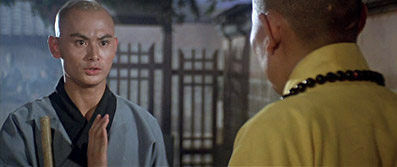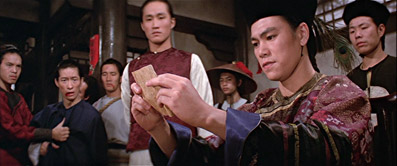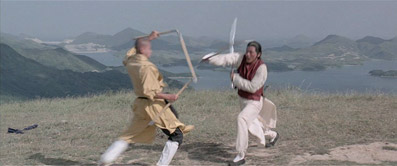|
A small pop quiz for those who've never seen it. Care to guess which genre The 36th Chamber of Shaolin [Shao Lin san shi liu fang] belongs to? If you need a clue, take a look at that DVD box artwork to the right or any of the screen grabs below. Know also that it was made in 1978 when this distinctive branch of action cinema was in full flow and the spells between combat were more like pauses to get your breath back.
Five minutes into this one, a hopeful warrior attacks a procession with the intention of assassinating the overlord of an oppressive occupying army. It turns out to be a trap, and despite his considerable martial arts prowess, he is eventually defeated and killed. Now how much screen time would you estimate will elapse before the next fight? Ten minutes? Fifteen at best? Try seventy-seven minutes. OK, that's not completely fair, it's seventy-seven minutes until the next conflict-based fight, and there are plenty of training bouts before then, but you still have to wait an hour for the first of those. Clearly The 36th Chamber of Shaolin is far from your average martial arts movie.

In Ching dynasty China, the Tartar army holds brutal and oppressive sway. Rebel fighter General Yin attempts to assassinate the Tartar Inspector General in a suicidal attack that is foiled by General Tien, and Yin's body is put on public display as a warning to others. When student Liu Yu-de quietly proclaims Yin a hero, he is almost arrested by Tartar military officer Lord Tang sang-yao – only some humble crawling by Liu's uncle Wang gets him off the hook. Angered by what they have seen, Liu and two of his fellow students join the underground movement, relaying messages to and from the rebel army led by Lord Cheng, who's off recruiting soldiers in Taiwan. When one of the students is caught in the act, Tang takes his troops into town to hunt out his co-conspirators, including Liu, who arrives home as Tang and his boys are ransacking the family seafood shop. Liu goes into immediate hiding and soon has his sights set on Shaolin, his intention being to learn martial arts from the monks in order to better fight the oppressors. He's attacked and injured en route, but when he stops for water at a small trading post, the proprietor hides him in a basket of goods being transported to the Shaolin temple. The monks heal his injuries and return him to full health, and although an outsider, his arrival is seen as fate by the elders and they agree to accept him as a trainee.
At this point the story is effectively put on hold for almost an hour to focus on Liu – who is given the name San Te by the monks – and his five year journey from hopeful novice to martial arts master, and there's an awful lot to learn before he gets a whiff of the fight training. And yet this is utterly compelling stuff, playing less like a martial arts movie than a historical drama in which martial arts eventually play a key role, which is exactly how it should be viewed and appreciated. The early scenes of Liu's involvement with the rebellion and his escape to Shaolin are as breathlessly paced as anything you'll find in modern Hollywood, and are peppered with moments of high drama – three times Liu's escape is aided by the fatal self-sacrifice of others – that are never dwelt on or over-sentimentalised.

But it's once Liu becomes San Te and begins the long process of learning the skills and self-discipline he will require to become an effective fighting machine that our engagement is complete. Like similar (if far shorter) sequences in any number of other genre and genre-influenced movies, The Karate Kid included, there's both a fascination with the trainers' unorthodox methods and a buzz of satisfaction that comes when San Te masters each task. The expected humiliations to be overcome are there – a test to encourage lightness of step that drops the initially unsuccessful San in the drink – but they are conquered not by wily thinking but perseverance and determination, the way we'd all like to think we'd do it if we had to.
It really helps that leading man Chia Hui Liu (aka Gordon Liu) makes Liu/San Te such a likeable hero, his decency, energy and unwavering determination making him a noble embodiment of audience wish-fulfillment. Of course, failure on his part is never really on the cards, a genre staple that comfortably survives the film's reshaping of traditional elements. It's also seriously foreshadowed by a deliciously shot opening credits sequence, in which the shaven-headed San Te demonstrates a range of skills he has yet, at least in narrative terms, to clap eyes on, let alone master.
By the time the fighting kicks off you've almost forgotten that this is a martial arts film at all. But when the action starts it just doesn't let up, providing a blistering final half-hour of almost non-stop combat, fabulously choreographed by director Liu Chia-liang (just watch some of the work involving San's triple-iron flail). A fighter of some skill himself, in this dual role he knows just how to present the action to camera, peppering his mobile mid and long shots with some striking observational wides.
Once he's completed his training, invented a new weapon and outraged the temple hierarchy with his suggestion for a 36th chamber of learning (there are traditionally 35), San is sent out on a mission of penance and the main story picks up almost where it left off, with the surviving characters still in conflict but the balance now tipped by the skills of this walking weapon of Shaolin. A few brief pauses in combat to set up the finale – which includes a quite spectacular ambush involving enough flour to bake bread for a small nation – do nothing to decelerate the pace, the action culminating in an inevitable but still immensely satisfying one-on-one between San Te and General Tien, who is played by none other than Lo Lieh, the incorruptible hero of King Boxer.

The 36th Chamber of Shaolin was one of the few major old-school martial arts films I caught neither on its cinema run or its later video release, so this was a first viewing experience for me, and I just loved it. Having offered my share of excuses for the thin plotting of much of martial arts cinema, to see one from the first wave so confident with its storytelling and characters that it's able to put the action on hold for half of film is a real thrill, and when the fighting starts then boy, you'd better be ready. Realised on a sometimes grand scale and weaving social and historical elements into a narrative that is fast-moving but never superficial, The 36th Chamber of Shaolin is, for my money, one of the great works not just of the martial arts genre, but of action cinema in any of its guises, and quite simply the best martial arts training movie you're ever likely to see.
Along with King Boxer, which is being released simultaneously by Momentum, this marks the UK debut of the Weinstein brothers' Dragon Dynasty label, which was initially set up to bring prize examples of Asian cinema to US DVD audiences in the manner that Hong Kong Legends once specialised in over here. As with the King Boxer disc, the 2.40:1 anamorphic transfer here is a glorious thing to behold, in the picture sharpness and detail, in its sometimes resplendent colour, and in the near perfect contrast, solid black levels and excellent shadow detail, and there's not a sign of damage to be seen anywhere. Film grain is sometimes visible and just occasionally there's a momentary quality slip, presumably the result of restoring the film from multiple sources, but for the most part it's hard to believe we're looking at a restoration of a film made in the 1970s.
There are three soundtrack options, the original Mandarin, Cantonese and English dubs. The choice between Mandarin and Cantonese is a matter of personal preference – I can speak neither, but the Mandarin seems to match the mouth movements and expressions of the actors slightly more accurately than the Cantonese. The English dub has the usual drawling American accents, with the voices of the older monks providing some unintentional comedy. All three have been very nicely cleaned up, with only the English track betraying a hint of crackle behind the dialogue and splendid sound effects.
Commentary Andy Klein and The RZA from Wu-Tang Clan
Two fan boys coming from different directions and backgrounds are nonetheless united in their passion for the genre and this film in particular. As with the King Boxer commentary, the plethora of information provided is tempered slightly by the sense that you'd need to pass a few film geek exams to be part of this conversation or even make sense of the odd bit. RZA even knows the dialogue for whole scenes off by heart, so if you dislike it when someone says a line just before the character then be prepared for some occasional irritation. On the whole, though, a very informative extra, and the pair's enthusiasm is infectious.

Interview with Gordon Liu (16:18)
The intensely likeable and still youthful-looking Liu (incorrectly spelt Lui on the interview's title screen) explains how he got into kung fu (he wanted to learn the hardest style, while his family were against the whole thing because they thought people who learnt kung fu were rude) and the movie business, as well as providing some background on his work on the film, especially the difficulty of handling the triple-iron. He believes the shaven-headed look helped him because he is "not handsome – I just know kung fu," although in Japan they apparently thought it made him look like Yul Brynner.
Interview with The RZA (9:47)
Wu-Tang Clan co-founding member, The RZA, summarises and expands on areas touched on in the commentary, including his introduction to kung-fu cinema, his enthusiasm for Shaw Brothers productions, his favourite genre directors and his love of this particular film.
Interview with David Chute & Andy Klein (7:35)
As with their King Boxer contribution, a useful roundup of key information about the film, including some background on director Liu Chia-Liang and leading man Gordon Liu.
There are two trailers, Trailer 1 (1:04) looking like a new cut from the remastered print, though it does have an authentic Chinese voice-over, while Trailer 2 (3:48) is clearly the real deal, an almost dialogue-free, all-action piece aimed at the American market and in surprisingly good shape.
There's also a Picture Gallery containing 3 posters and 27 stills, and brief Commentary Biogs for Andy Klein and The RZA.
What went for the Momentum/Dragon Dynasty release of King Boxer also goes here, and if you're a martial arts fan then this disc is a dream come true – a great film, gorgeously transferred and with some solid extras. I'd also suggest that the film might represent a good way in to old school kung fu cinema for action movie fans you have yet to take the plunge, while the drama is involving enough to give it appeal outside of the usual fan base. Highly recommended.
|